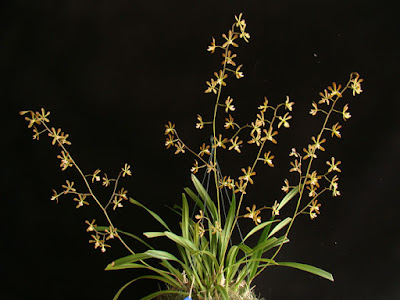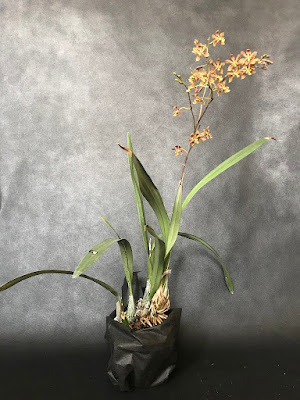Encyclia diota - Two-eared Encyclia flowers are showy, fragrant, 2 cm in diameter with olive brown to chocolate sepals and petals and dark yellow lip
Encyclia diota, also called as Two-eared Encyclia, Encyclia insidiosa, Epidendrum diotum, Epidendrum insidiosum, is a species in the genus Encyclia. This species was described by Rudolf Schlechter in 1918.
DESCRIPTION OF ENCYCLIA DIOTA - TWO-EARED ENCYCLIA
Encyclia diota is native to Southern Mexico to Central America. It is found growing in pine-oak, and tropical deciduous forest in El Salvador, Guatemala, Honduras, Mexico Southeast, Mexico Southwest, Nicaragua at elevations of 200-1800 meters above sea level.
It is a medium sized, hot to cool growing epiphyte, lithophyte or terrestrial which reaching up to 50 cm in height with conical, ovoid, wrinkled, 5 cm long pseudobulbs that are covered with scaly sheaths. The leaves are 1 or 2, 25 cm long, conduplicate at the base, coriaceous, generally purple on the underside.
Two-eared Encyclia blooms in spring from the apical, 30 to 100cm long, minutely verrucose, racemose or paniculate, 10-80 flowered inflorescence that arise on a mature pseudobulb. The flowers are showy, fragrant, 2 cm in diameter with olive brown to chocolate sepals and petals and dark yellow lip with carinate veins, orange anthers. Sepals are elliptic, acute, dorsally carinate, thickened at the apex, slightly concave, with 5 main nerves, with involute edges. Petals spatulate, sub-acute. Lip has 3 lobes near the base, adnate to the column, dorsally carinate; lateral lobes with obtuse apex, occasionally bifid with the basal half surrounding the column and the apical half is patent; intermediate lobe is apiculate and with curved edges. Column without teeth or wings.
ENCYCLIA DIOTA - TWO-EARED ENCYCLIA CARE AND CULTURE
Cultural information should only be used as a guide, and should be to be adapted to suit you. Your physical location; where you grow your plants, how much time you have to devote to their care, and many other factors, will need to be taken into account. Only then can you decide on the cultural methods that best suit you and your plants.
Light:
Encyclia diota needs a light level of 25000-35000 lux. The light should be filtered or diffused and the plants should not be exposed to direct midday sun. Strong air movement should be provided all the time.
Temperature:
In summer, the average day temperature is 27-30 °C, and the night 17-19 °C, with a daily amplitude of 8-10 °C. In winter the average daytime temperatures are 25-27 °C, and 16-18 °C during the night, while the daily amplitude is 8-11 °C.
Humidity:
Two-eared Encyclia needs the humidity of 80% in the period of growth, in winter and spring it falls to 60-70%. Too dry air has a negative effect on the development of the plant: its growth is inhibited, and the leaves begin to turn yellow and dry out. The higher temperature, the higher the humidity should be, and the higher the humidity, the more often and longer it is necessary to ventilate the room where the plants are contained, otherwise the probability of rotting and various kinds of fungal diseases. Good air movement is essential while the plants are in leaf and growing.
Substrate, growing media and repotting:
Encyclia diota are most often grown in pots or baskets with a very thick, loose and well-drained substrate. There should be plenty of space in the pots to allow the roots to dry quickly after watering. It is recommended to use smaller pots sufficient for only one or two years of growth, because the substrate in larger pots remains wet after watering for too long. Roots that do not dry out quickly enough after watering rot. Most growers recommend medium grain bark, though others prefer medium cork pieces mixed with large lumps of charcoal.
The plants also grow well mounted on tree-fern or cork rootstocks, provided that high humidity is ensured. Fixed plants require high humidity and at least daily watering in summer, and in the case of dry and hot weather, it may be necessary to water several times a day.
Transplanting or splitting is best done when new roots begin to emerge, or immediately after blooming. This allows the plants to acclimate in a relatively short time and provides them with the least stress.
Watering:
The plants should be watered abundantly during active growth, but their roots must dry out quickly after watering. At the end of autumn, the amount of water should be gradually reduced.
Fertilizer:
Two-eared Encyclia should be fertilized every week 1/4-1/2 of the recommended dose of fertilizer for orchids. A fertilizer with a high nitrogen content is beneficial from spring to mid-summer, and a phosphorus-rich fertilizer can be used in late summer and autumn. Higher phosphorus content stimulates better flowering in the next season and promotes hardening of new growth before winter.
To avoid the accumulation of mineral deposits during periods of strong fertilization, it is recommended to rinse the containers approximately every month.
Rest period:
Encyclia diota needs a dry rest period in winter. Allow the plants to dry a bit before the next watering, but do not let the remaining ones dry for long periods of time. In most cases, light watering every 2-3 weeks and occasional morning misting between waterings are sufficient. Fertilization should be limited or should be abandoned altogether until spring, when stronger watering resumes.















COMMENTS